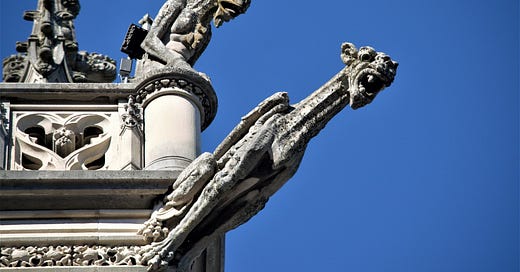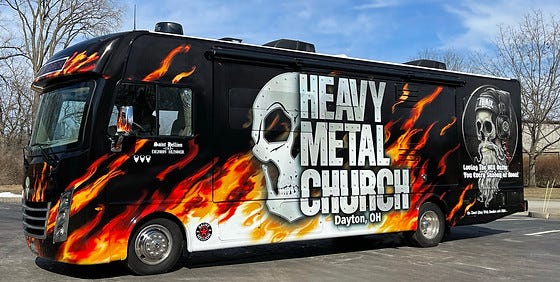Back around the 13th Century when cathedrals were first being built, architects realized they had a problem with accumulating water. So instead of slapping an ugly gutter on the side of the roof, they inserted spouts to drain the runoff and (more important for this conversation) brought them up to the same aesthetic standard as the rest of the building.
This is important because instead of simply placing a tool on the sides of cathedrals they put symbols. A symbol is a place where meaning meets matter. It’s an incarnation of sorts, pointing both at a physical and metaphysical reality.
But what does the gargoyle symbolize, you might ask. What higher purpose could these ugly, grotesques point towards?
Some folks have said that they are a warning to sinners of the torturous Hell awaiting them if they don’t repent. Others claim that they embrace the strange and ugly aspects of the world. As for me though, I think it’s exactly what it looks like: an image of the margin.
Gargoyles exist on the edge of churches. They’re half-humans, half-monsters. Like frogs, in one of my previous posts, they are “symbolically amphibious,” straddling the line between order and chaos. They’re always a little bit funny, a little bit uncomfortable, and not something that you’d readily invite into your home.
But as marginal figures, they play an important purpose. They serve as a transition point between two worlds in the same way a town on the borderlands between two kingdoms will likely share characteristics of both. This is the point where two kingdoms experience the exchange of languages, ideas, and perspectives. Furthermore, they serve as a distillation of whatever tensions there are between the two kingdoms.
Strip Mall Churches
Now, I’m going to show you the 3 largest churches in my area.
Eagle Brook Lino
River Valley Apple Valley
Hosanna Church Lakeville
What do you notice about them? No gargoyles, clearly. But what’s more is that they all look like some cross between a shopping mall and a public school. They’re sleek, shiny, and hyper-efficient. They have neat, clean parking lots and none of that troublesome old architecture that reminds us of medieval times when everyone was sick and dirty and dreadfully uncomfortable.
There are nice coffee shops and convenient places to drop your kids off. The chairs are comfy. The music is new and entertaining (to some folks). And most importantly, the sermons are formatted and delivered like Ted Talks. All-in-all, a great place to kick back and relax after a tough week of work.
But no gargoyles.
What does mean symbolically? It means that there is no margin to these churches. There is no place for the in-between. There is no space of transition. You are either in or you are out.
Now, some might say that in terms of Biblical Cosmology, that’s exactly what you get. You are saved or you are not. You go to Heaven or you go to Hell. But there’s something missing in this equation and that is the space in between.
It’s earth1. It is the place and time in which we currently live. It is the state where we are perpetually caught in the tension of Heaven and Hell, of salvation and damnation, of the Always Will Be and Never Again. We are all spiritual gargoyles in this sense, marred by sin and a broken world but not without hope.
The way that this spiritual image of lack-of-margin manifests is that we act as if we already know the details of people’s salvation. We take a look at someone and say that they are damned for Hell when in reality, only God knows the state of someone’s soul.
This “We are the Judge” mentality is how puritanical or fundamentalist mindsets come to be.
You’ll notice that almost all of these churches (pictured above) that could just as well be office buildings are protestant denominations. Now, I’m protestant myself, but I’ll admit that one of the largest problems with Protestantism is that part of its core identity is rooted in the rejection of something, IE the Catholic Church that it broke off from.
By rooting its identity in rejection, we see that this results in fragmentation instead of unity. In terms of denominations, Catholicism and Orthodox Christianity have something like 50 total between the two of them. Protestantism, on the other hand, is estimated to have something like 1000+ denominations by itself.
Furthermore, by exiling all instances of ambiguity, our theology becomes shallow and lacking in depth. An example of this is how protestant churches fight and fracture over the issue of communion.
Some folks will say that the bread and wine of the eucharist physically transforms into the body of Christ where others will say it is simply a metaphor for the body of Christ.
The older and more nuanced way of looking at this issue, however, is that the bread and wine simply are the body and blood.
“What do you mean, like, Christ is made out of bread and wine or that he becomes these things when taken in communion?”
No. It simply is the body of Christ.
“Wait, so if Christ isn’t physically and materially bread and wine at some point, then you must mean he is like bread and wine. He metaphorically brings people together, as bread and wine do.”
No. It simply is the body of Christ.
Our inability to hold strange things at the margin is reflective of the fact that we as a culture can no longer handle mystery. We can’t not know how something works or exists so the example of the Eucharist must fall into one of these two categories: physical description or metaphorical description.
But by simply dwelling in the mystery of what cannot be explained, we humble ourselves to it. We give ourselves up to it and let it transform us instead of attempting to dominate it through ways of knowing.
Gargoyles at the Center
Now, the opposite thing we get in America is taking gargoyles and putting them at the center of things. I mentioned last week that I’ve spent a lot of time watching and participating in the Christian Heavy Metal scene, which are certainly gargoyles if there ever were any.

And since the proliferation of Christian metal, a (small) number of churches have sought to replace their modern worship bands with metal bands. Now, this isn’t common, and it is a very specific kind of church that does this. But this is one of those “gargoyles at the center” moments where a celebration and centering of something that should be on the margin does damage to the idea of Christian worship as a whole.
Again, I like metal music. It’s basically all I listen to. But I don’t want it at church. Its place isn’t at church unless we’re doing a kind of once-a-year carnival inversion where something like that might make sense. But on the whole, I don’t even like rock music in church. If I want to go to a rock or metal concert I’ll just go to one at my local venue and it’s probably going to be much better.
I realize I’ve been talking a lot about Christianity here but the layout of the altar at the center and the gargoyles on the edge is about the best imagery I can think of for how things hold onto their identities and remain cohesive.
For example, we understand that a mammal is an animal with warm blood, hair/fur, and mammary glands. We also understand that the duck-billed platypus is something of an exception with its webbed feet, duck bill, and ability to lay eggs. The platypus is still a mammal but it would be foolish to hold it up as the gold-standard of what a mammal is, anatomically speaking, seeing as its characteristics are quite unique.
Or take that horrible (but apt) thought experiment about whether or not a hotdog is a sandwich. It obviously isn’t but it’s also hard to pin down exactly where we draw the line if we’re bringing sub sandwiches into the equation, as subs are often made with a single piece of connected bread much like a hotdog.
The question here isn’t about hotdogs or platypus’s or gargoyles. The question is about how we draw lines between categories and what we do with the things that sit right on top of those lines with one foot in either territory. It’s a question of our ability to handle ambiguity and uncertainty.
And the more we try to expel the gargoyles from our lives and tidy them up to fit into a certain category that they don’t fully belong in, then we can no longer perceive the wholeness of the world with its myriad of complexities. We can’t walk into an untamed wilderness without bringing along our sheers and gardening hoes. We can’t contend with the fickle mysteries that fill in the narrow margins of the world. And we can’t experience the transformative blessings that those marginal things have to offer.
Some might notice that I didn’t capitalize “earth” here. This is on purpose as I’m referring to the ancient notion of earth as the “material realm” as opposed to the modern notion that we are on Planet Earth. In an ancient worldview, Mars or Europa might also be “earth” were we to walk on them.








